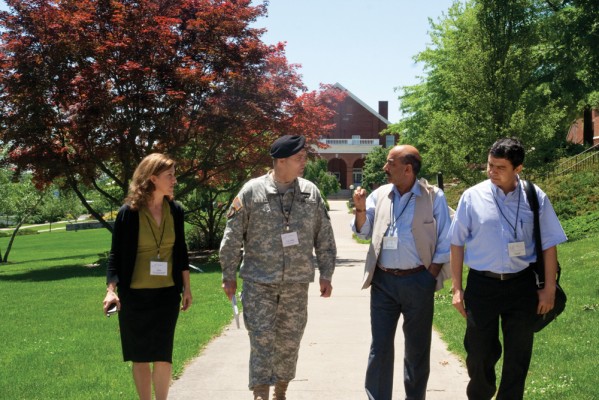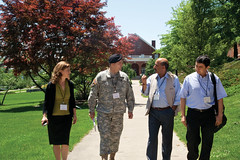Dr. Lisa Schirch, director of the 3D Security Initiative and EMU professor of peacebuilding, and Chic Dambach, president and CEO of the Alliance for Peacebuilding, prepared this summary for Peacebuilder of their extensive list of recommendations for policymakers considering changes to the U.S. Foreign Assistance Act in 2010.
A robust commitment to and investment in peacebuilding to advance peace and mitigate crises is essential for U.S. foreign assistance goals to succeed. Without a safe and stable environment, all other development efforts are vulnerable. Civil wars and regional violence have destroyed development projects, costing tens of billions of dollars.
There are long-term costs to foreign assistance guided by short-term goals and chronic underfunding of civilian agencies. Too many resources go to short-term, crisis-response strategies. Too few are appropriated to long-term sustainable development strategies that advance peace and help mitigate crises. A more robust commitment to and investment in peacebuilding will save money and lives. It will help establish secure foundations for more effective long-term development.
Peacebuilding as an Essential Element of U.S. Foreign Assistance
- Definitions: Peacebuilding includes a wide range of efforts by diverse actors in government and civil society to address the root causes of violence and protect civilians before, during, and after violent conflict. Before conflict becomes violent, preventive peacebuilding efforts–such as diplomatic, economic, social, legal and security sector reform programs – address potential sources of instability and violence. This is also termed “conflict prevention.” In the midst of a violent crisis, a range of peacebuilding efforts aims to manage, mitigate, resolve and transform central aspects of the conflict through official diplomacy, as well as through civil society peace processes and informal dialogue, negotiation, and mediation. In the post-crisis phase, a range of peacebuilding efforts addresses root causes of violence and fosters stabilization, reconstruction, and reconciliation to prevent the return of instability and violence.
- Peacebuilding costs less than expensive, complex military operations after a crisis emerges. In comparative studies, researchers find peacebuilding programs to prevent violent conflict cost far less than waiting to intervene after conflicts turn into crises and violence. Research shows that, on average, one dollar spent on preventive programs compares with approximately sixty dollars of program costs to respond to crises once violence erupts. For this reason, governments, inter-governmental organizations and nongovernmental organizations are making serious commitments to advancing peace and mitigating crises through effective peacebuilding programs.
- A U.S. capacity for peacebuilding requires a comprehensive rethinking of U.S. foreign assistance and security interests, but it does not require a radical overhaul of infrastructure or costly new programs within U.S. foreign assistance. Proportionately small increases in U.S. foreign assistance budgets could have dramatic effects in mitigating crises and advancing peace, and should correspond with reductions in the military budget. Effective peacebuilding requires effective early warning systems, flexible funding for rapid response and organizational capacity to coordinate strategy and operations.
- Given the complex nature of most violent conflicts, peacebuilding requires a systemic, comprehensive approach with multiple stakeholders actively partnering with other sectors. Effective peacebuilding requires coordination among the U.S. government and other actors including: the United Nations; regional organizations like the OSCE, the African Union and ECOWAS multilateral partners of the U.S.; national governments in the crisis regions, and international and local NGOs involved in development and conflict prevention. Coordinated conflict assessment, strategic planning and program implementation for peacebuilding among diverse government agencies and civil society actors is imperative. In spite of efforts to coordinate the newly established governmental programs in peacebuilding at the Departments of Defense, Justice, State and USAID, little communication occurs between these governmental bodies and well-established peacebuilding programs in civil society. A comprehensive approach requires a better infrastructure for communication and coordination.
- Peacebuilding requires recalibrating civil-military roles and relationships and developing a clearly articulated shared mission of building global human security consistent with national interests. Global perceptions of a militarized U.S. foreign policy hamper U.S. foreign assistance goals aiming at long-term development, human rights, and good governance. Currently there are severe imbalances between civilian and military actors’ resources, capacity and expertise. This requires new measures to fund, identify, recruit, train and deploy civilian experts in both government and civil society at both the strategic planning and operational planning levels. Strategic planning for civilian missions requires knowledge of and experience in the areas of civilian-crisis response, such as strengthening police, the rule of law, civilian administration and civilian protection.
- The sustainability of peacebuilding efforts rests on local ownership, leadership, and capacity that upholds the dignity of men, women, boys and girls. Peacebuilding should first and foremost identify and strengthen existing social capital and sources of community resilience that can and do withstand and mitigate violence and promote peace and social cohesion. Foreign assistance has an important role in supporting local government and civil society efforts. Too often, however, foreign assistance is not connected to local peacebuilding initiatives and ends up inadvertently undermining these through short-term, quick-impact projects implemented by consultants who do not understand the local context and language and who fail to earn the respect and support of local people. Foreign assistance supports peacebuilding when it exhibits understanding of and respect for local history and culture, while appreciating the dynamic ways cultures and conflicts change over time. The principles of the Universal Declaration of Human Rights and more recent international laws should inform U.S. foreign assistance, ensuring that traditionally marginalized social groups (e.g., women, youth, minorities) are fully respected and included in all processes — in ways that they themselves determine most appropriate.
- Peacebuilding necessitates a balance between strengthening weak and failing states and empowering civil society, which has proven to be an effective moderating force. State capacity to perform its essential functions is important to peacebuilding. Yet often development and peacebuilding efforts to support new governments have excluded and undermined local civil society. In many regions of the world, robust and innovative civil society-led peacebuilding efforts are already underway. Civil society helps to transform non-democratic countries through informing public opinion, mobilizing constituencies for reform, and engaging government and political parties in policy debate. Civil society organizations lay foundations for development, human rights, and foster cross-cultural exchange, often through the arts. They mediate between armed groups or opponents to help reach ceasefire agreements. They facilitate dialogue and promote tolerance between groups. They deliver humanitarian relief to, and foster trauma healing in, war-affected communities. Civil society’s strengths lie in their long-term cultural and linguistic knowledge of and commitment to the local context. Civil society works to ensure governments act on behalf of everyone’s best interests and not just the interests of a few.
- Peacebuilding depends upon operational and political space for civil society. Civil society organizations working against extremism by promoting human rights, development, and peacebuilding can be themselves hampered, deterred and unfairly punished under current counterterrorism laws and restrictions. U.S. foreign assistance must recognize and take actions to protect the vital roles of civil society, ensuring they have the political and operational space necessary to fulfil their important missions.
- Peacebuilding requires accountability mechanisms for transparency and evaluation. Accountability mechanisms also facilitate local participation, information sharing, and dealing effectively with unintended outcomes. Evaluations should capture lessons learned and best practices and be shared widely to inform future peacebuilding initiatives.
The Relationship Between Development Assistance and Peace
- Violent conflict is “development in reverse.” Countries with low per capita incomes and low rates of economic growth are more likely to experience civil war and pose larger security threats to the global community. Violent conflict often channels resources toward war rather than development, creates refugees, fuels traffic in drugs and weapons, causes environmental damage, and destroys livelihoods and lives. Without a safe and stable environment, development efforts tend to be nullified, wasting the investment.
- The relationship between poverty, state fragility and conflict is complex. Poverty can contribute to conflicts, particularly those stemming from ethnic dominance and perceived political, social, and economic exclusion and humiliation. Most people who pick up a gun or strap on explosives are motivated by local and immediate issues such as daily security, discrimination, inadequate basic services, pervasive corruption, impunity for well-connected elites, denial of a political voice, inadequate justice, and lack of employment opportunities. They are different from the relative handful of extremists wishing to advance their global ideological agenda through massive destruction and disruption; the locals can be de-coupled from the globally oriented extremists, if positive alternatives are offered. Conflict-sensitive foreign assistance can offer such alternatives.
- Fragile and failed states are more likely to experience civil wars that threaten development and undermine global security. Fragile and failed states serve as hothouses for the growth of ethnic, sectarian, secessionist, and other internal wars, as well as sanctuaries, recruiting areas, and havens for drug- and weapons-trafficking, often linked to insurgencies. Peacebuilding helps rebuild failed and failing states.
- Conflict-sensitive foreign assistance programs can help to reduce poverty while advancing peace and mitigating crises through peacebuilding programs. Development programs can:
- Disrupt the patterns of civil war that threaten security and undermine efforts to reduce poverty in a variety of ways.
- Pre-empt the ability of extremist groups to mobilize support from the population in need of basic services.
- Empower local change agents who can make demands on their government for transparency and accountability.
- Discourage violence by addressing perceived grievances and offering better economic alternatives than the incentives provided by armed groups.
- Weaken local support for violence by spreading the economic benefits of peace.
- Foster middle class and civil society actors who can put a brake on political violence.
- Humanitarian and development programs can inadvertently contribute to conflict and violence. The impact of development programs on preventing conflict depends on both the level of investment and the quality of development programs. Underfunded or misconceived programs can worsen problems in four ways:
- When development resources are perceived to benefit some groups but not others, they can exacerbate existing tensions between groups.
- Inadequate funding relative to population size can inflate expectations and lead to competition and conflict over development assistance programs and resources. Lack of consultation and local ownership in development projects can miss important insights into how to address locally identified needs of those sympathetic to terrorist groups.
- When development assistance is suddenly withheld or repeatedly used as a “stick” to punish support for specific groups, it can actually increase support for these groups if they are providing aid and charity in the vacuum of international humanitarian support.
- If external development assistance frees up local resources for war, it can relieve local leaders of their responsibilities to provide basic services and aid to their citizens and thus undermine efforts at building state capacity and legitimacy necessary for stability.
- Foreign assistance should include development programs that take into account the impacts of conflict on development projects and the effects of development projects on conflicts. This can be ensured by:
- Identifying the impacts of conflict and violence on humanitarian assistance.
- Avoiding inadvertently worsening tensions or exacerbating conflict.
- Designing programming aimed at both reducing poverty and preventing violent conflict by addressing key divisions between groups and underlying grievances that fuel conflict.
- Supporting local capacities for peace and community resilience to conflict.
- Generating options for improving program quality in planning, implementation, monitoring, and evaluation, so that development efforts address key divisions between groups and underlying grievances that fuel conflict.
The 3D Security Initiative’s and Alliance for Peacebuilding’s full, official document of recommendations for the U.S. Foreign Assistance Act in 2010 can be found at www.3dsecurity.org. These recommendations represent the views of the authors and their organizations and should not be construed as being the official position of Eastern Mennonite University.

